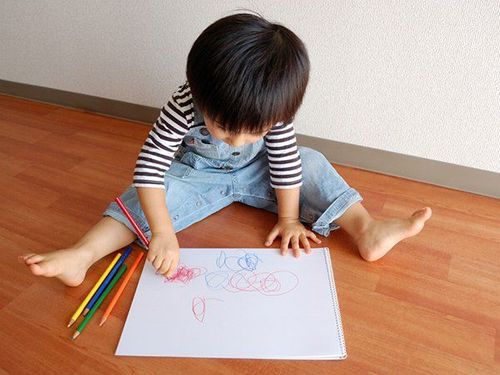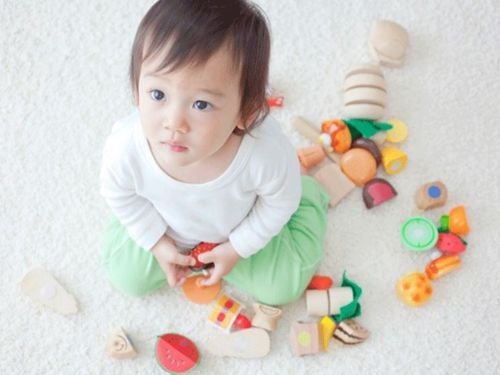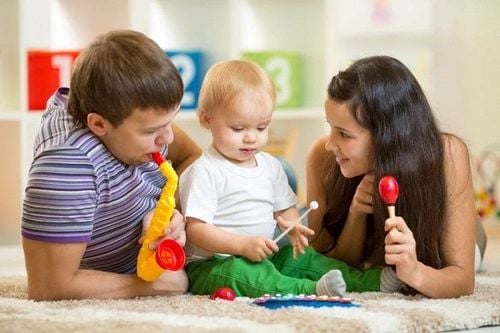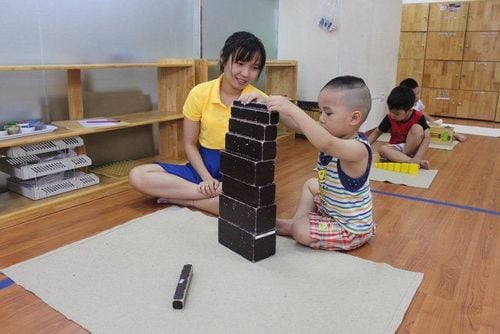This is an automatically translated article.
Einstein once said: “Imagination is more important than knowledge”. In fact, imagination is not only a great tool but it also ensures that your child will never run out of ideas in everyday life. However, not everyone knows how to help children develop creativity.1. Creative characteristics of children
The world of preschoolers is a world of imagination and magic. For many children, their creativity will peak before the age of six, then it will begin to decline as children begin formal schooling and develop toward adherence to what they are taught.Supporting your child's creativity in preschool will set the stage for fostering their continued development in the years to come.
By the age of 3, children officially enter the pre-active period of intellectual development, the hallmark of which is the ability to use symbols and representational thinking. Children may use a word, drawing, or item to represent something else. For example, the letters “horse” or a picture of a horse, or even a stick with a stocking, all of which represent an actual horse the child knows.
The 3-year-old discovers that he can put blocks in an arrangement, or scribble on paper in a way that represents an object or action.
The child's fine motor skills have developed enough that the child can control writing instruments or manipulate objects with greater precision, which will develop further in the following years as preschool children. Children this age begin to create with a clear purpose, like drawing a monster or a flower on purpose.
With these new performance possibilities, children's imaginations are boundless! Children love pretend play and have a natural tendency to imagine, experiment, and explore. Children are fascinated with magic and struggle to distinguish between fantasy and reality.
However, children's creative motivation arouses curiosity and supports intellectual development in all subjects. So this is the perfect time to support the development of creative thinking. Time for kids to create unique solutions and make new connections without being tied to a single “right answer” or a certain way of doing things.
Supporting divergent thinking means providing activities that allow children to learn, think, wonder, be curious, and even support appropriate confusion. Thinking differently and thereby creating to solve problems is not just art, it is thinking, anticipating, imagining and creating.

Đứa trẻ 3 tuổi phát hiện ra rằng mình có thể đặt các khối theo một cách sắp xếp, hoặc viết nguệch ngoạc trên giấy theo cách thể hiện một đồ vật hoặc hành động
2. The role of art in the development of creativity in children
There's a reason painting, drawing, and crafts are such an important part of the preschool curriculum, and it's research that shows that art makes kids smarter.Eric Jensen is a researcher and author of the book "Art with the brain in mind" once said, "Art enhances the learning process". Children who are taught drawing and art do better in school, are able to retain information longer, have more confidence, and develop better independent thinking skills, says Jensen.
3. What to do to encourage children to be creative?
You can help your child discover the hidden artistic possibilities within. By creating an art collection in a plastic bin with supplies like scratch paper, markers, crayons, glue, scissors, sticks, and cotton.Preserve your child's creations, to show him you appreciate his hard work and creativity. There's nothing like the gratification of seeing one's hand-crafted work appreciated by everyone.
If your child is a perfectionist and is constantly frustrated with what he sees as a mistake, you need to guide your child to enjoy what he has just accomplished. You and your child can sew, embroider, make jewelry with beads, sculpt with scrap wood, etc.
You can also refer to the ways below to promote creativity:
3.1.Encourage creative problem solving Ask children open-ended questions without right or wrong choices. Encourage your child to tell you why he thinks so, does so. This helps promote creativity, cognition, and language development. For example, "What if cats could talk?" or "If you had to choose between keeping your eyes or your nose, which would you choose and why?".
Accept any answer as “enough”, but try to help your child go further with more questions or curiosity whose answers inspire you.
3.2.Offer a variety of experiences Offer your child a variety of experiences to build your child's knowledge base. For example, have your child go to the museum, visit the library, and explore different neighborhoods in your town.

Hãy cung cấp cho trẻ nhiều trải nghiệm khác nhau
Prepare recyclable materials such as egg cartons, cardboard boxes, etc. to make plans that encourage children's creativity.
If you worry about the mess? Make a plan in which your child can use foil, pasta, buttons, paint, glue, sprinkle with glitter, add virtual leaves or "crowned" paper and you will be amazed at what they can do. Children can do with these items.
3.4.Breaking the rules To encourage your child's creativity, you should break the rules. Encourage your child to do different things. Some fun ideas are:
Instead of playing board games by rules, see if your child can play freely. Go for a picnic in the winter. This is sure to be a very enjoyable experience. See how many different uses your child can think of for paper clips or rolls of tissues. Instead of using regular paint, mix safe ingredients with vegetable oil to make color paint. Try turmeric, paprika (color), and cumin (smell) on watercolor paper and see how these colors react to light. Add salt to paint or beans to play dough. Have your child create the alphabet with spaghetti or pasta. Rekindle your child's forgotten passion: Add cotton balls on abandoned train tracks and declare an avalanche! Or ask your child to help put out the “fire” on the roof of the dollhouse (use red, orange, and yellow tissue paper to simulate the fire). Engaging children to think and solve problems in this way will not only spark their creativity, but also stimulate familiar games in new directions. 3.5. Provide a variety of openers You can also stimulate the creativity of young children by providing them with open tools, and seeing what they will do with them. Open tools such as:
Animal puppets Doctor tool kits or kits Vehicle models Various blocks Clothing Clay, play dough, pipe cleaners, paints, chalks, a variety of tools writing tools...

Bạn cũng có thể kích thích sự sáng tạo của trẻ nhỏ bằng cách cung cấp cho trẻ những công cụ mở
3.7. Encourage creative storytelling Ask your child to draw pictures to represent the stories he tells. For a favorite story, switch something. Make the protagonist a bear instead of Goldilocks, or have the story take place on a ship instead of a forest.
3.8. Real and playful support Many children this age will ask you to draw or write for them, so they can look up to it and learn from it. Honor this desire without setting a standard they are unlikely to achieve.
3.9. Create creative movements Especially if you have a wiggler, try these creative moves:
Ask your child to do the wiggles. Ask your child to show you how she would move if she was sad, angry, or happy. Ask the child to choose how an animal should move. How can the child cross the hill or cross the river like that animal? 3.10. Think about how your child does it Emphasize the process, not the product. Ask your child to tell you about their creation. Notice what your child has discovered, for example: he noticed that when you layer green, you get a darker color.

Hãy cố gắng nghĩ về cách trẻ thực hiện chứ không phải kết quả
Parents can learn more:
Why do you need to supplement Lysine for your baby?
The role of zinc - Guidelines for reasonable zinc supplementation
Please visit the website Vinmec.com regularly and update useful information to take care of your baby and family.
References: babycenter.com, scholastic.com, mumcentre.com













